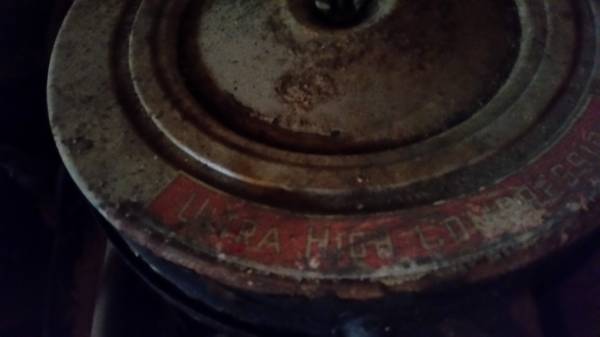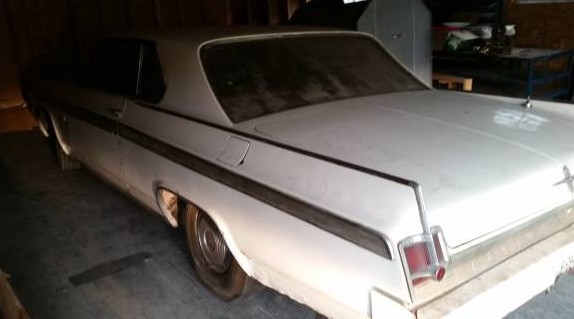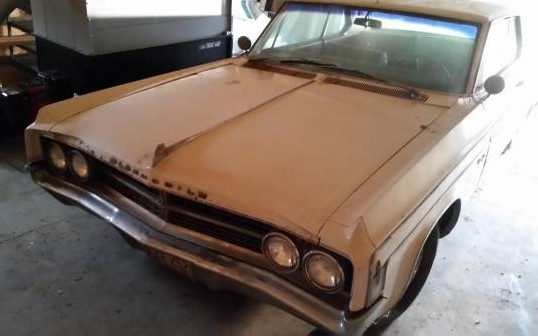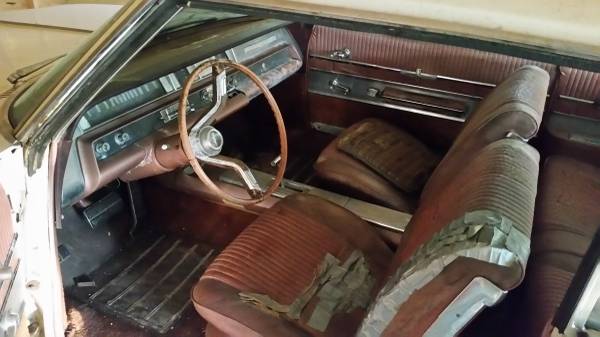There is a lot of debate about which car was the very first muscle car, some say it’s the GTO while others say Cadillac and Oldsmobile were both selling hopped up street racers as early as 1949. Of course those early cars aren’t quite the standard definition of a muscle car. That being said, there is no doubt they helped shape the muscle car era. After the Rocket 88, Oldsmobile followed up with the Starfire, which in ’61 was about as much a muscle car as you could get power wise! This example is listed here on craigslist in St. Louis, Missouri is this 1963 Starfire listed at $3,800. Bruce, the owner, says that this is “Barn Fresh” and is an unmolested car. But is this Oldsmobile’s first “real” muscle car?
The Rocket 394 V8 is under the hood, the owner reports it puts out 345 horsepower, others state 330. Either way, that’s a decent helping of power and well in muscle car territory!
There is some rust, according to the owner, in the lower rear quarters.
There is not an image of the inside of the truck, the underside, and/or the headliner which would be nice to see.
This Starfire has been sitting in a machine shed since 1984. This is a non-running restoration project, but it is a titled Starfire, which is a good start. The mileage, if the engine spins, or any history is not reported. The body does look straight and this might be a great project if you want a ’63 Starfire. So if the ’49 Rocket 88 isn’t a muscle car, was this generation of Starfire Oldsmobile’s first muscle car or was it just another stepping stone?
Motor-on,
Robert






Without question, the 1st Olds muscle car was indeed the ’49 Rocket 88. The Starfire, I always thought, was more of a luxury cruiser, like the Grand Prix or Wildcat.. The Starfire, like the Grand Prix, was just too darn heavy to be a muscle car, ( even though, they could be had with 4 speeds) but it was one of the nicest GM’s of the era. It’s a shame what the Starfire had become in the late ’70’s. A mere shell of what a great car it was. Lot of work here, but seem to bring 5 figures no problem when finished.
The ’49 Olds Rocket 88 was not a muscle car – Olds’ or any manufacturer’s. The retroactive use of the much maligned term simply muddies the water. Just as the ’63 Olds’ Starfire is not a muscle car – closer to a T-Bird-ish “personal car”.
The ’49/50 Olds was quicker than some of its contemporaries, but not particularly fast. Per the July 1950 Motor Trend road test it had a 0-60 time of 12.44 sec in drive or 12.22 sec using low & drive. That’s good. However, its top speed – best one way run was 92.11 mph with an average of two way runs of 91.75 mph. This was a test of a 4 door 88 sedan which weighs only 80 lbs more than a 2 door coupe.
Dave at OldScholl Restorations was incorrect when he said, “this was basically a lightweight Chevy Coupe with and OHV V8″, in the ’49 Oldsmobile posting. The 88 coupe had a 119 – 1/2″ wheelbase and weighed 3550 lbs vs the ’49 Chevy coupe with a 115” wheelbase and a weight of 3090 lbs ie: 460 lbs lighter than the Olds.
The ’49/’50 Chevy couldn’t match the Olds acceleration, but with a top speed of 88.93 mph had a decent turn of speed.
Before someone chimes in with “but the Ford flathead V8s were 100 mph cars” – sorry, nope, never the case. The ’53 Ford flathead V8 had a top speed of 87 mph whereas the ’53 Ford six topped out at 86 mph. Inaccurate speedometers that read as much as 10% + fast allied to granddad’s, pop’s or his monkey’s uncle’s tall tale(s) created these “old wives’..er mans’ gibberish tales.
Only in the mid fifties did American cars come closer to the magic 100 mph mark. Of 24 cars tested in ’54 by Motor Trend only 6 reached or exceeded 100 mph with the Cadillac 62 having a top speed of 113 mph and 0 – 60 time of ll.3 seconds compared to the Olds Super 88 with a top speed of 108 mph and a 0 – 60 time of 12.4 seconds.
Interesting Big 3 top speed data from ’54:
Chevy Two Ten w/Powerglide – 92.4 mph
Ford Customline six w/ overdrive – 93.7 mph
Ford Customline OHV V8 Fordomatic – 87.7 mph
Plymouth Belvedere Hy-Drive – 82.4 mph
BTW the Hudson Hornet with Hydramatic was timed at 100.3 mph
@James Apparently you were not around in the early 50’s. The Olds coupe was THE car you did not want to see appear Saturday nite, especially when
it had a stick
It was ‘basically’ a Chevy Coupe. Old engineers put this car together to BE the Muscle car that it was … and it was, on drag strips and round tracks EVERYWHERE…
.When a neighbor rolled his ’49 sedan in ’55, we put the motor,trans, and rear axle assembly, with no driveshaft in the rear of my Crosley ‘convertible’ drag car.
Wen I finished building my 47 Chevy fastback with a 3/4 Jimmy 302 sixbanger, I could not beat a prepped ‘ 49 303 V8 Coupe , and the Jimmy six had great TORQUE off the line.
Hmmm…….magazine and reference books versus the real life experience of Dave. Great pix from ’59……oldskool rules!
Dave at OldSchool Restorations & Woodie Man
Ah yes, I do remember the ‘50s – even the early ‘50s – and particularly 1950 as I anticipated going to school in Japan. However, the North Korean Army poured over the 38th parallel and Dad went to Korea, but by the mid ‘50s we were based in a – to me – strange land – Nascar land – the land of Jim Crow laws and Ford and Chevy feuds. Chuck the Olds, Pontiac and Plymouth…well not always the Plymouth. The Pontiac made the cut in the late ‘50s.
As you can imagine drag racing wasn’t a biggie. Crosley’s? Yeah, a brand new ’51 convertible family machine with a wee OHC four.
Anecdotal info w/o specific recorded data may seem valid, but having a career working with scientists, R&D engineers, production engineers and other manufacturing professionals including a smattering of the American and Japanese auto industry folks, I’ve found that w/o specific or actionable data one cannot move forward.
My own coupe in 1959 was a ’47 Ford. Due to budget constraints, the mods amounted to bucket seats (no seat belt), 15” wheels and tires to improve handling and gain an imperceptible, but desired lower drive ratio. Dreaming. Hubcaps tossed because even with a crap suspension lowering unsprung weight was important. I managed to out drag a ’56 Ford V8 3 speed with Dad’s ’56 Nash OHV 6. So what. When I raced the same kid over a 15 mile run an hour glass could have been used to record the time between my finish and the other kids arrival minutes later. Still the Ford was technically the faster of the two cars.
In the same light I remember the days of the nebulas 3/4 race and full race cams when the cam grinder, in many cases, provided no info on valve overlap or valve lift. I’m sure you put together a good engine and I liked the GMC 6, but once again we have an unknown vying with a “prepped” (another unknown) so let’s stick with specific info that fits your view of the ’49 Olds 88.
In 1977 ex-Oldsmobile engineer, Harold Metzel (part of the Rocket 88 team) under general manager, Sherrod E. Skinner was asked if Olds “did” or “didn’t” support the enthusiast appeal of these early machines. His reply, “We did–half heartedly. There was a mixed feeling in management at that time as to solid benefits.”
Metzel claimed he presented “test data” (I like that) from a trip to Phoenix (90 octane fuel purchased at airports) to Skinner and chief engineer Jack Wolfram that convinced Skinner to seek and finally gain corporate approval for the 88. The engine itself was not without faults, but they were discovered on test runs including one to Colorado where they burned so many valves they basically made it back on two cylinders. A bit of an exaggeration one suspects. They did continue to have valve train problems as they raised the compression ratio to 7.5 : 1 in ’51 and 8.0 : 1 in ’53. By ’56 it was up to 9.25 : 1 producing 240 hp (mfgs claim) and burning valves again. So according to the Olds’ engineer all was not hunky dory. For the rest of us the SBC arrived in ’55 and that was the performance engine for some time to come.
Once again you say “was “basically” a Chevy Coupe”. I understand where such a myth comes from. The Chevy, Pontiac and Olds used the corporate General Motors A-body, appropriately massaged for the short Chevy chassis or longer Pontiac and Olds chassis. Here’s where it’s necessary to point out just a few of the major differences that account for the much higher weight penalty the Olds coupe had and also the benefits. One, the chassis was not only 4 1/2” longer, but it also had a massive X-frame, heavy sway bars front and rear and, as an ex-road racer (SCCA not vintage) my favorite, “larger brakes”. The Chevy’s piddly little brakes were 1 3/4” wide front and rear with a lining length of 20 5/8”. By contrast the Olds had 2 1/2” wide linings in the front and 2” linings in the rear with a length of 21 5/16”. The reality is the Olds coupe was an Olds coupe – much heavier and 5 inches longer and brake size was based on weight.
Anecdotal spoiler alert – if you were ever arrested and plopped into a filthy cell block populated by unsavory societal ner-do-wells (murder, assault, armed robbery, etc.) in the basement jail of the local county sheriff & police headquarters because you tried to stretch your lead over the highway copper too much and forgot that American brakes were only good for one – just one – solid 100 plus mph “road race” attack on a hairpin turn. It’s disheartening to have all the anchors tossed out and passing your turn off at 50/55 mph when at 30 you’re going to use all the tarmac, the miniscule shoulder and probably the ditch to get the job done. Oh hi, officer, just noticed your lights. Miles ago you say. Must pay more attention to my mirrors. The trials and tribulations of a ’57 2 door hardtop w/327 V8, 4 barrel and stock brakes in 1961. Real life can be exhilarating. A stunt like that today might get you killed. Good for me the highway patrol officer who had set up the road block and arrived later was the one who caught his hand in the continental spare release mechanism. The arresting officer had a county mounty with him and was not pleased to have the kid embarrass him by out running him till the kid kindly “stopped”. Expensive lesson learned.
Back to our regular scheduled ’49 Olds. Performance car OK. Muscle car? Nah. Term didn’t exist then. They did better than OK in Nascar in ’49 and ’50, but in ’51 the Hudson Hornet arrived and it was down hill from there. Even in 1950 Ford, Plymouth, Mercury, Lincoln and Nash offered solid competition. The Southern 500 was won by a Plymouth and Lee Petty won the 200 mile race on the Hillsboro, NC one mile dirt track in a ’49 Plymouth with Buck Baker in ’50 Olds 2nd followed by 2 more Plymouths with an Olds in 5th with 3 more Plymouths, a Lincoln and a Mercury filling out the top 10.
The 1950 Carrera Panamericana was an impressive win for Herschel McGriff at an average speed of 78.421 mph with placing in the top three (3rd place) only on the 9th leg when the winning Nash was disqualified – correctly so as only the assigned driver and co-driver could get behind the wheel. The Connor/Green team had elicited the aid of another Nash driver who’s car had crashed. The Nash beat the McGriff by 8 1/2 minutes on this final and toughest section.
In summary it’s easy to see how the story line of the Chevy coupe developed because of the use of the Corporate A-body and being enthralled with the V8 w/o recognizing all the other engineering built into the Olds so it could be sold to Olds’ buyers not all looking for performance – rather a notch up over Pontiac or a couple of notches up over a Chevy.
correct sir, Car Craft took a 2nd Gen Camaro project car to El Mirage. Photo showed 130 mph on the speedo, PEGGED OUT as we use to say. Actual speed 118 mph. After putting in a 5sp and rear gear it would actually spin the tires enough it couldnt get much past 120. The reason was the rear spoiler on those cas actually cause rear lift at those speed. Either they removed it or shaved it i cant remember that part, but it would do the 130 afterwards. The old auto trans where horrible for putting power down. Thats where the term “SLUSH BOX” came from.
Had a ’64 Super 88 with the 394. Wonderful car, smooth as butter on the highways, but it had a “cold” idiot light that made a very audible “plink” when it went out after getting to operating temperature. Always caught me off-guard
Have owned several..loved ’em. I have not seen nice ones command big money…will take lotsa green stamps to make this nice..
Some of these cars may have been BOUGHT w/ green stamps.
57 Olds 88 with the 371 inch V-8 and the J-2 option (tri-power) was a pretty potent combo in its day, especially with the 3 speed manual transmission, pretty close to the definition of muscle car. Always thought ’63s like the one featured today were big and boaty
The 1949 olds only had like 130 hose power at the engine .The axel only abought 90
Absolutely not. By the common everyday definition of using an engine from the full size car in that manufacturer’s midsized chassis, the 1965 442 is the first car to fit. Additional parts of that definition also always includes toughening the suspension to match. Which other Olds does that. None.
Being a Mopar guy, this will sound biased but I always thought the 55 Chrysler C-300 was the first “muscle” car.
My first car, after learning how to drive on a ’63 VW bug, was my grandma’s ’63 Olds Super 88 Holiday 4-dr. I wouldn’t call it a muscle car, as it was too big and heavy, but it would get up and go as long as the plugs didn’t foul. I’d love to find another one or a ’63 Starfire, but this one is a little more work than I can handle.
I would tend to agree but most folks put those 300s in the high performance option category, similar to the 409 Impalas, 406 and 427 Galaxies, 421 Catalinas and so on. Those HiPo options were always generally quicker/faster than muscle cars. 421s never did make it down to the GTO level. 427s were generally unavailable in the Fairlane GTAs and certainly the 409s didn’t get put into the Chev IIs nor Chevelles.
In the end, the muscle cars weren’t really king as long as the big hi performance engines were readily available in the big cars. One solid reason for that was the insurance companies couldn’t tell by the VIN what engine you had. But on the muscle cars, the VIN gave it away and the ins. premiums went up.The HiPo big cars were faster anyway as most of them could run 114 to 121 in stock drag classes. Muscle cars virtually all had hydraulic lifters and ran 95 to 105 in the stock classes. Muscle was popular but High Performance optional engines were really king in the early muscle days.
Tricky discussion of “first muscle cars”! Of course, Studebaker fans like ’56 Hawks and Paxton supercharged ’63 R3 Avantis
Beat me to it! I was going to make mention of Studebaker. I had a stock 1952 commander that was very fast, of course overdrive helped.I had a convertible and a 2 door commander hardtop starliner. nice cars